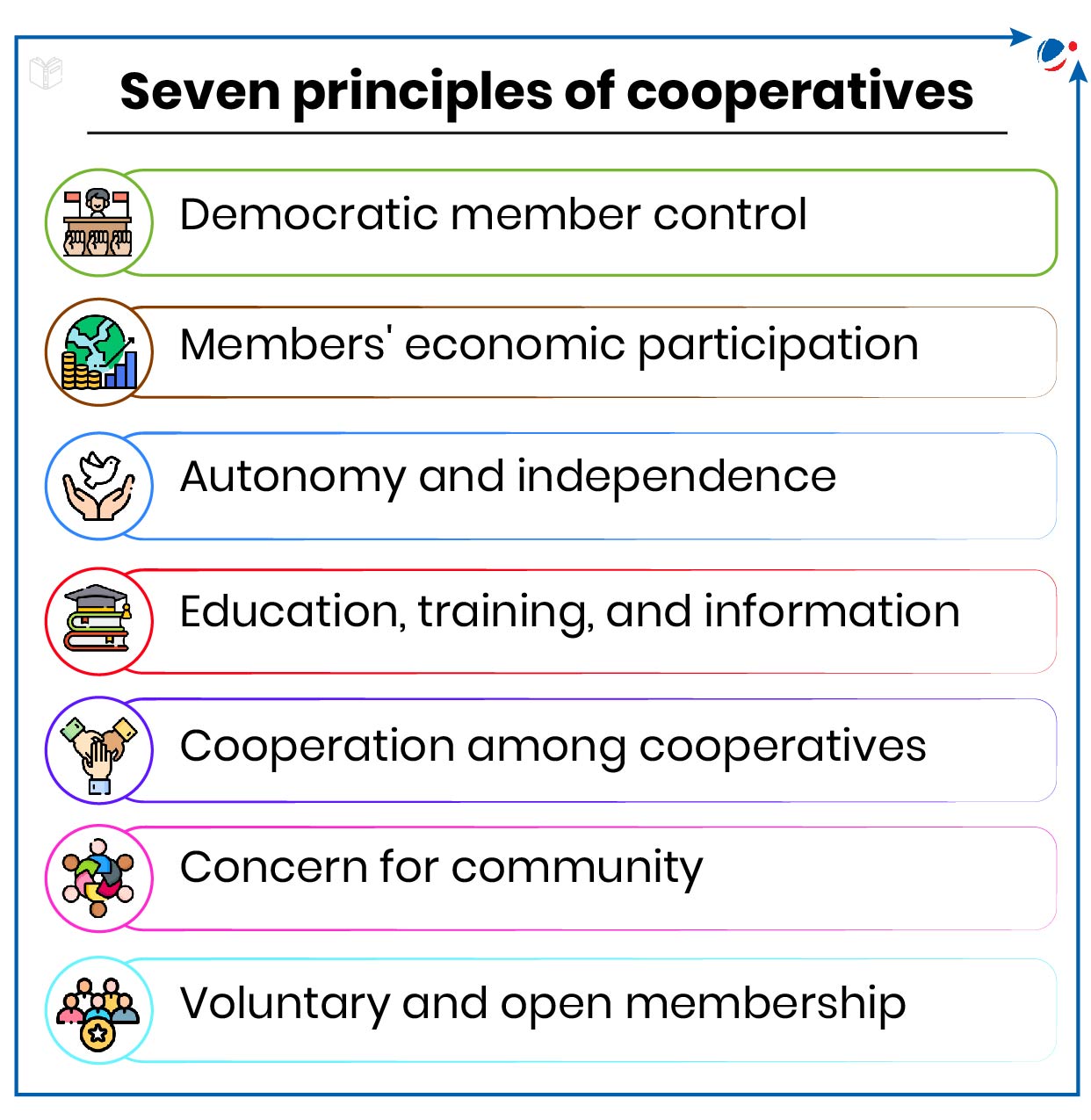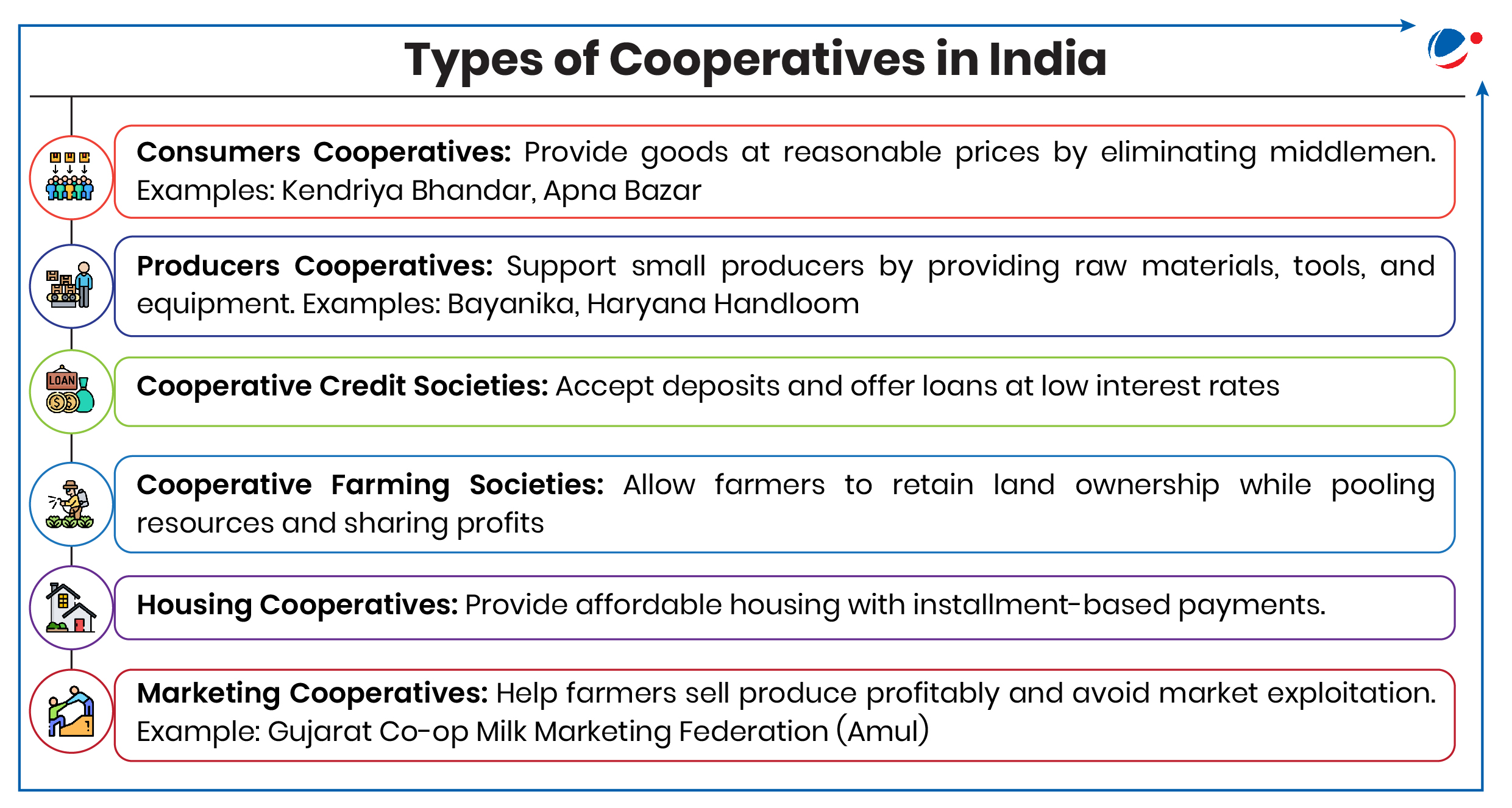Union Home Minister and Minister of Cooperation and Prime Minister of India inaugurated the UN International Year of Cooperatives 2025 (IYC 2025).
About IYC 2025
- Proclaimed by: United Nations General Assembly in June 2024
- Theme: "Cooperatives Build a Better World"
- Objectives
- Raise Awareness: Showcase cooperatives' role in sustainable development.
- Promote Growth: Strengthen the cooperative ecosystem.
- Advocate for Policies: Support legal and policy reforms for cooperatives.
- Inspire Leadership: Engage youth and foster cooperative leadership.
- Host: Committee for the Promotion and Advancement of Cooperatives (COPAC)

What are Cooperatives?
- Definition: A cooperative is a voluntary group of individuals with common needs who unite to achieve shared economic goals.
- Aim: Supports members, with focus on the interest of the poorer sections of society, through self-help and mutual aid.
- Resource Sharing: Members pool resources and use them effectively for mutual benefit.
- Cooperative Movement: The global rise of cooperatives is partially due to the work of the International Co-operative Alliance (ICA).
- Founded in 1895 by E.V. Neale and Edward Owen Greening, the ICA is a global Non-Governmental Organization (NGO) promoting worker cooperation.
- In November 2024, India hosted ICA's Global Cooperative Conference for the first time.
- The Theme was "Cooperatives Build Prosperity For All", aligning with India's "Sahkar Se Samriddhi" vision.
Cooperatives in India
- Genesis: Started with the Cooperative Credit Societies Act, 1904.
- Current Status: India holds 27% of the world's cooperatives. 20% of Indians are part of cooperatives (global average: 12%).
- Top 3 Cooperative sectors: Housing, Dairy, and Primary Agricultural Credit Society (PACS)
- Leading States (57% of total cooperatives): Maharashtra (constitutes 25% of India's cooperatives), Gujarat, Telangana, Madhya Pradesh, Karnataka.
- Constitutional Status: 97th Amendment, 2011 granted constitutional status to the Cooperative Societies with following provisions-
- Fundamental Right: Added "cooperative societies" in Article 19(1)(c).
- Directive Principle: Inserted Article 43B to promote cooperatives.
- New Part IXB: Added Articles 243ZH to 243ZT for cooperative governance.
- Governance Structure
- Multi-State Cooperatives: Falls under Entry 44 of Union List of the Constitution. Governed by the Multi-State Cooperative Societies Act, 2002.
- State Cooperatives: Falls under Entry 32 of State List of the Constitution. Governed by respective State Cooperative Societies Acts.

What are Cooperatives banks?
|
Significance of Cooperatives in Socioeconomic Development
- Strengthening Social Cohesion: Cooperatives foster natural and private social bonds without third-party involvement.
- Example: Housing cooperatives bridge the gap between residents and urban policies, encouraging grassroots participation.
- Empowering Society
- Equal Rights: The "one-person-one-vote" system ensures equality.
- Bargaining Power: Enables collective action for better opportunities.
- Leadership Development: Cooperatives elect leaders democratically, helping develop leadership skills in many states (e.g., In Maharashtra many legislators are associated with cooperatives movement).
- Promoting Financial Inclusion: Affordable credit for farmers, reducing reliance on moneylenders. Extensive rural network boosts financial accessibility.
- Reducing Wealth Inequality: Loans at low interest rates support marginalized communities. Encourages self-employment and fair competition.
- Instilling Moral Values: Promotes unity, trust, honesty, and cooperation, ensuring social stability.
Challenges Faced by Cooperatives in India
- Governance Issues
- Government Interference: Regulations on borrowing, transactions, and investments limit efficiency.
- Politicization: Powerful local figures influence cooperative management.
- Lack of Awareness: Many members and directors are unaware of cooperative objectives and rules.
- Internal Rivalries: Quarrels and tensions reduce active participation.
- Limited Reach and Inefficiency
- Regional Imbalance: Cooperatives are underdeveloped in northeastern and eastern states.
- Small Societies: Limited membership and resources hinder growth.
- Single-Purpose Focus: Cooperatives lack a holistic approach to solving community problems.
- Operational Challenges
- Weak Audit System: Audits are irregular, delayed, and ineffective.
- Lack of Coordination: Cooperatives at different levels fail to work together.
- Functional Weaknesses
- Lack of Scale: Cooperatives struggle with financial, managerial, and technical limitations.
- Skilled Workforce Shortage: Training institutions and professional opportunities are lacking.
- Poor Management: Limited career development affects leadership and efficiency.
- Lack of Familiarity with Digital Tools: The data indicates that only 45% of cooperative members are familiar with digital tools, suggesting a significant gap in technological literacy.
Key Initiatives to Strengthen Cooperatives in India
Institutional Support |
|
Legal & Governance Reforms |
|
Economic & Infrastructure Growth
|
|
Technology & Financial Inclusion
|
|
Strengthening the Cooperative Movement in India
- Structural Reforms
- Merge Weak Societies: Combine inefficient cooperatives with stronger ones to pool resources and improve efficiency.
- Promote Multipurpose Societies: These societies can address multiple needs of members, ensuring balanced and integrated development.
- Improve Operational Efficiency
- Cooperative societies need professional managers in the areas of their core business and financial management, etc.,
- Streamline Loans: Ensure loans are used productively and repaid on time.
- Enhance Coordination: Establish better links between different cooperative bodies for mutual support.
- Skilled Administration: Recruit trained personnel and simplify cooperative procedures.
- Capacity Building
- Skill Development: Train employees, students, and aspiring cooperative members in cooperative management.
- Digitization: Implement digital tools for governance, banking, and business operations to enhance transparency and efficiency.
- Public Awareness & Education
- Mass Awareness Campaigns: Promote cooperatives through public outreach and initiatives like Jan Andolans.
- Value-Based Education: Teach ethical behavior and cooperation from a young age.
- Strengthen Legal Framework: Implement the Narasimham Committee's recommendations for cooperative banking.
- Ensure Transparency:
- Bring cooperatives under the RTI Act.
- Provisions of CBI and CVC inquiry against malpractice societies and banks has to be introduced.
- Strengthening internal audit system or conduct of concurrent audit in cooperative will reduce the risk and bring in more professional approach.
- NABARD is working towards developing a Cooperative Governance Index (CGI) for rural cooperative banks to assess and improve governance standards.



